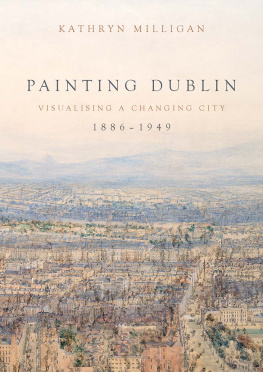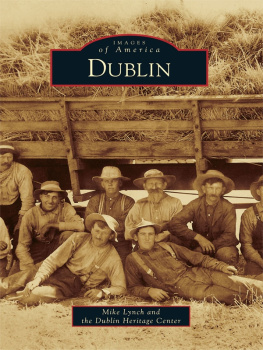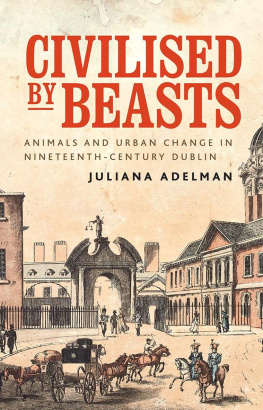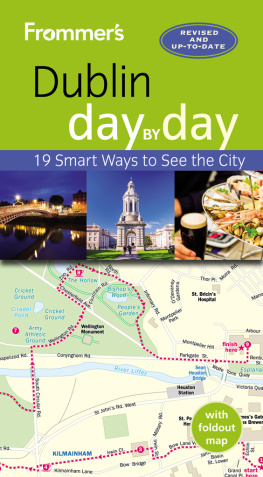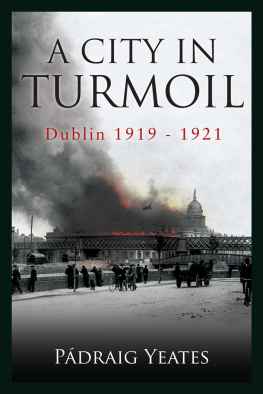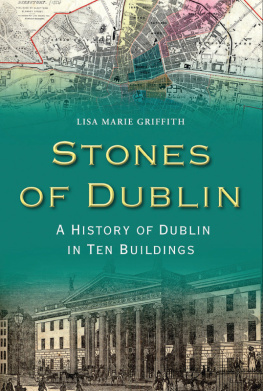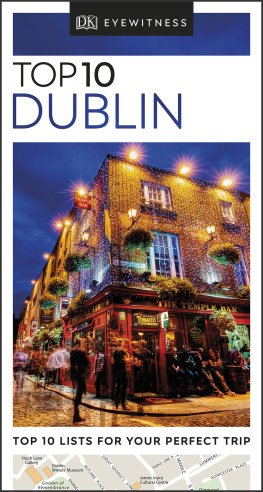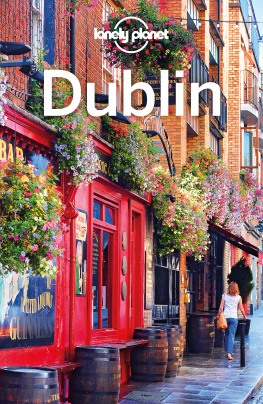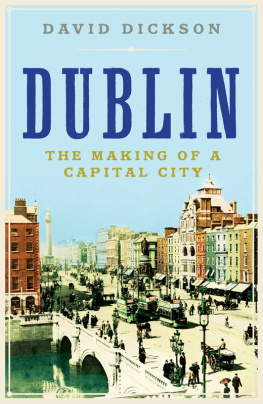Painting Dublin, 18861949

Painting Dublin, 18861949
Visualising a changing city
Kathryn Milligan
Manchester University Press
Copyright Kathryn Milligan 2020
The right of Kathryn Milligan to be identified as the author of this work has been asserted by her in accordance with the Copyright, Designs and Patents Act 1988.
Published by Manchester University Press
Altrincham Street, Manchester M1 7JA
www.manchesteruniversitypress.co.uk
British Library Cataloguing-in-Publication Data
A catalogue record for this book is available from the British Library
ISBN 978 1 5261 4410 2 hardback
First published 2020
The publisher has no responsibility for the persistence or accuracy of URLs for any external or third-party internet websites referred to in this book, and does not guarantee that any content on such websites is, or will remain, accurate or appropriate.
Image credit: James Mahony, Dublin From the Spire of St Georges Church, Hardwicke Place, c. 1853 (National Gallery of Ireland). Cover design: Daniel Benneworth-Gray.
Typeset in 10/12 Apolline Std by
Servis Filmsetting Ltd, Stockport, Cheshire
Contents
Note: As there is no known copyright holder for Flora H. Mitchell, her works cannot be reproduced in this volume. However, the original watercolours for her Vanishing Dublin publication are available to view on the National Gallery of Irelands website, and the relevant object numbers have been listed in the endnotes. The catalogue can be accessed at onlinecollection.nationalgallery.ie. It has not been possible to include reproductions of some private collection works, but many of these are available online through auction house records.
My first thanks go to those who have offered support, feedback, and mentorship at different stages of the research and writing of Painting Dublin: Yvonne Scott and Philip McEvansoneya, Department of History of Art and Architecture, Trinity College Dublin; Emily Mark Fitzgerald, UCD School of Art History and Cultural Policy; and Nicholas Allen, Willson Centre for the Humanities and Arts, University of Georgia.
An Irish Research Council Government of Ireland Postdoctoral Fellowship at the UCD School of Art History and Cultural Policy (201719) was crucial for bringing this book to completion. This fellowship enabled me to conduct further research abroad, travel to international conferences, and provided much needed funding to source images for publication. During this period, I was a Resident Scholar at the UCD Humanities Institute, and I offer sincere thanks to Anne Fuchs, Director of the HI, who ensures that the Institute is a sheltering and stimulating environment for early career researchers. The benefit of having a dedicated workspace, shared with other postdoctoral and postgraduate scholars cannot be underestimated, especially in these times of academic precarity. I am particularly grateful to the cohort of H105: Sarah Comyn, Stephan Ehrig, Sarah Galletly, Alison Garden, Scott Hamilton, Shonagh Hill, Britta Jung, Megan Kuster, Zosia Kuczyska, Dan OBrien, and Sarah Sharp. I would also like to thank Valerie Norton and Ricki Schoen, UCD Humanities Institute; Carla Briggs, Philip Cottrell, Kathleen James-Chakraborty, Conor Lucey, and Elizabeth Varley, UCD School of Art History and Cultural Policy, for making my time at UCD so fulfilling. I have frequently benefitted from the advice, knowledge, and support of Ewelina Bykuc, Marie Bourke, Nicola Figgis, Angela Griffith, Gearid Hayes, Risn Kennedy, Niamh McGuinne, Niamh McNally, Donal Maguire, Brendan Rooney, Ellen Rowley, and the committee members of the Dublin History Research Network.
I am grateful for the additional financial assistance offered by the National University of Irelands Publication Grant Scheme. Emma Brennan and Alun Richards at Manchester University Press have been a pleasure to work with; I would also like to thank the anonymous readers who gave insightful feedback on my proposal and manuscript.
The following people were instrumental in gathering together the images reproduced in this publication: Louise Morgan and Leah Benson, National Gallery of Ireland; Berni Metcalfe, James Harte, and Glenn Dunne, National Library of Ireland; Philip Roe, Dublin City Gallery the Hugh Lane; Anne Boddaert and Michael Waldron, Crawford Art Gallery; Johanne Mullen, Irish Museum of Modern Art; William Derham, OPW Dublin Castle; Antoinette Prout, Royal Irish Academy; Catherine Giltrap, Trinity College Art Collections; Phil Pound, Morgan ODriscoll Fine Art Auctioneers and Valuers; James OHalloran, Adams Auctioneers; Chris Sutherns, Tate; rna Roche, UCD Digital Library; Sharon Sutton, Digital Resources and Imaging Service, Trinity College Dublin; Arabella Bishop and Beatrice Moller, Sothebys; Stephen at the Picture Library of the National Museums of Northern Ireland; Mark at the Oriel Gallery; and staff of the British Museum Images Service, Getty Images, Harvard Art Museums, and the New York Public Library. Thanks also to Chris Walsh of IVARO Irish Visual Artists Rights Organisation, and the representatives of the estates of Estella Solomons and Harry Kernoff.
I am immensely grateful to those at the National Gallery of Ireland who have continually supported my research and enabled me to share aspects of it with the public: Sarah Conroy, Joanne Drum, and Sinad Rice deserve special thanks, as well as the wonderful voices of the National Gallery of Ireland Workplace Choir who provide a much needed respite from writing on Tuesday evenings. I have been blessed with a wonderful group of friends who have, in turn, offered good advice, cups of coffee, and pairs of keen eyes over the course of this process. My sincere thanks go to Myles Campbell, Catherine Coughlan, William Derham, Sarah Maguire, Caroline McGee, Niamh Nic Ghabhann, Fariha Shaikh, Colleen Thomas, and especially to Lisa Towell.
My final thanks go to my family: my parents, Lou and Henry; Jennie, Donal, and beloved goddaughters Rachel and Eleanor; Rick, Kate, and darling nephews Edward and Charles. This book is dedicated to Grace Madigan, my favourite flneuse and Dubliner: thank you for being endlessly cheering, patient, questioning, and supportive.
| DCGHL | Dublin City Gallery the Hugh Lane |
| DMP | Dublin Metropolitan Police |
| DMSA | Dublin Metropolitan School of Art |
| DORA | Defence of the Realm Act |
| DSC | Dublin Sketching Club |
| FSR | Friends of Soviet Russia |
| GPO | General Post Office |
| IRA | Irish Republican Army |
| NGI | National Gallery of Ireland |
| NLI | National Library of Ireland |
| RA | Royal Academy of Arts |
| RDS | Royal Dublin Society |
| RHA | Royal Hibernian Academy |
| RIC | Royal Irish Constabulary |
| WCSI | Watercolour Society of Ireland |
From the top of the steeple of St Georges Church, Hardwicke Place, the city of Dublin stretches out across the canvas in a maze of streets and houses (). Black, skeletal watercolour ships trace their way to-and-fro across the bay and up the river, carrying goods and people into the heart of the conurbation, while hazy blue mountains lie on the horizon, connecting land, sea, and sky. On close examination, the mass of rooftops and chimneys separate out into recognisable forms: the viewer of this painting can identify some of the citys eighteenth-century squares Mountjoy, Parnell, and Merrion Square the Rotunda Pleasure Gardens, the parkland of Trinity College and St Stephens Green, the broad sweep of Sackville Street, and the curve of College Green. Looking closer still, sculptural and architectural features emerge: Nelsons Pillar rises beside the portico of the General Post Office on Sackville Street (renamed OConnell Street in 1924); equestrian monuments of William III and George II are seen on Dame Street and in Stephens Green, along with the campanile in Trinity College and the Rutland Memorial Fountain on Merrion Square. In addition to landmark buildings like the Custom House and Rotunda Hospital, the glass dome of the exhibition hall, constructed for the Irish Industrial Exhibition in 1853, extends along Leinster Lawn.

